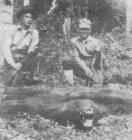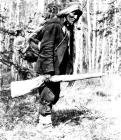1
It was a very good yearIt is the year 1915. Al Huble and his partner Ed Seebach have been traders working from the head of the Giscome Portage for 11 years. Three years ago Al married and brought his new wife and her two children to the portage. He built a new solid squared log house and continued to run a thriving business trading, freighting goods and farming. This exhibit will bring you to the Giscome Portage to experience what our early settlers and entrepreneurs experienced by telling the whole story of a single year at the portage, a place which is today know as "Huble Homestead". The story is told using documents, interviews, and photographs which include both historic photos and special photos taken at the portage that were "set up" just for this project. So get ready, relax, and enjoy A year in the life of Huble Homestead: 1915
Every season was chock full of things to do. Freight was hauled all year round. Spring time saw new visitors, riverboat freight to haul and repairs to the portage. Summer was spent tending the garden, as well as the store and trade from stations at Giscome Portage, Summit Lake and McLeod Lake. Fall was harvest time, pulling the last wagon loads of freight, setting up the animals for the winter and hiring the people of the First Nations to help with all of this as well as helping to build new buildings. In the winter the homestead/trading post received many visitors. Transportation was by dog team, Seebach and Huble also ran a trap line and actively traded furs.
2
Al Hubles DiaryDecember 21, 1914 to March 20, 1915
Monday December 21st, 1914 Worked repairing barn. Mild day.
Tuesday 22nd Put door on barn. Packer came from Crooked River. Heavy fall of snow.
Wednesday 23rd Worked at barn. Fine mild day.
Thursday 24th Used the snow plow with 4 horses. Ed and Bert returned from Ft. George.
Friday 25th Christmas Day. Stayed home at Giscome. Haynes, Wheeler, Baker, Sands, and wife here for dinner.
Saturday 26th Hauled up some plank off the river. Fine mild day
Sunday 27th Fixed pump and hauled up some plank off the river. Stormy day.
Monday 28th Went across Portage and got load of shake blocks. Fine day.
Tuesday 29th Went over and got a load of shake blocks. Fine day.
Wednesday 30th Stayed at home. Hauled wood and plank. Snowed all day.
Thursday 31st Went across and got load of shake blocks. Fine day.
Editor - The Fifth Diary continues into 1915
Friday January 1st, 1915 Went across and got load of shake blocks. Fine mild day.
Saturday 2nd Hauled cordwood. Fine soft day.
There is a little notation on the top of the next page. Incidentally he has run out of the formatted diary and he's starting to make his own daily entries now using a page headed "Weather Record". At the top of the page he has a note which must be a form:
Wolf and Hine. Fur overcoat $75.00 - mink trimmed
Sunday 3rd Drove out to Baker's. Fine cold day.
Monday 4th Went over and got load of shake blocks. Fine cold day.
Tuesday 5th Hauled stove wood. Fine cold day.
Wednesday 6th Went out and cut some barn logs.
Thursday 7th Went out to the wood and cut road. Cleared out Rol-way [sic roadway]. Fine day.
Friday 8th Cut logs for new barn. Fine mild day.
On the next page it appears that sometime earlier he got information about a coat for his wife. He indicated the number 12 over the word skin as if it would take 12 skins to make the coat.
$75.00 Large 12 skin coat. ladies. beaver.
20 small skins.
Collar 4 small mink.
Cuffs 2 small mink.
Muff 6 large 10 small
Hat 5 small
Bust, Hips, Length, Sleeve length.
He has a little diagram as if he was measuring a bent arm.
Man's Coat 12 skins. plucked. $70
Now he starts his daily entries again.
Saturday 9th Skidded barn logs. Brought first load home.
Sunday 10th Stayed at home. Sick all day. Fine mild day.
Monday 11th Done some blacksmithing. Fine mild day.
Tuesday 12th Skidded barn logs. Brought a load home. Fine day.
Wednesday 13th Stayed at home. Ed went to Ft. George. Cut road to wood. Bright day.
Thursday 14th Cut road to get out summer wood. Mild day. Light fall of snow.
Friday 15th Hauled in wood. Bright cold day.
Saturday 16th Cut road and hauled out some wood. Fine mild day.
Closing Entries of Fifth Diary
Indented comments by Witte
He has pre-dated entries 17, 18, 19 and 20 but the 16th is the last entry of this diary except for various misc. notes that are below. All of the days of the week are abbreviated in his own unique way. Sat. is Sa, Sun. is Su, Mon. is Mo, Tues. is Tu, Wed. is We, Thurs. is Th, Fri. is Fr. On the adjacent page to the last daily entry there is:
J. R. Fairar Y. W. C. A. Calgary
Number 12 wire $3.38 per hundred. 148 miles.
Right here there's a distinct change in the handwriting. Really good penmanship. Maybe Mrs. Huble is leaving a note for Al Huble.
Mr. Galbraith in charge of your orders.
Mr. White Ship Chandlery
Near the very last page it looks like Huble composed a speech or statement. I do not think he copied it because the spelling is terrible.
No one will deny the demoralization of any useful industry is in economic waste. A bad thing for the public at large and that its stayability based on a sure but moderate profit is the ideal condition for the consumer as well as for those directly or indirectly connected with its activities.
Wreckage always means waste and financial wreckage is no exception to the rule. A few individuals may secure a momentary benefit from an industrial failure but to society at large it invariably involves a final net loss. Labor suffers, investment suffers, and the body of business in general is disordered.
The modern association spirit is a good one. You can't beat it. Sneaking trade secrets and trying to throttle the man who happens to be your competitor belong to the dark ages of industrial competition. To the period of federalism the associations are now driven out of business. I would hate to think of any line being without an association. Instead of continually reacting for one another's throat we are doing something for the good of the line and everybody in it.
A couple of pages further on:
Farming Mills
inch 24 $30.00
Graham and Anderson
He seems to recall an order to this mill for flour.
Johnson Bros. wood vallance
Chamberlain median International Stock food Co.
Instructions to hold orders.
Great West Saddlery to ship when advised.
Now there are some more kids scribbles.
Graham and Anderson.
Chatam wagon $78.00 2 1/2 inch tire
24 inch Bulldog $30.00 without bajer [sic]
West Trains. Monday, Wednesday, and Friday.
More kids scribbles.
Mr. F. G. Adams division freight office . G. Y. P. Jasper Ave.
Mr. Fisher. Secretary Board of Trade. Edmonton.
Purvis Camp.
94 X 95 [Witte - or 915. It's hard to decipher.]
See if 7830 near Bean Creek is open.
N. E. 1/4 757 on Fraser near Bridge Creek.
755 across Fraser from 848. [Witte - This is circled.]
See Dr. Ritchardson [sic]
Ask Roberts about shares in pre-emption.
On the back of this same page, written most likely by Mrs. Huble because of the neatness, there is:
1 square yard of reinforced asbestos gasket sheeting.
See about width of road.
On the very last page of the diary is written the length of the page.
Richardson 1/2 mile above Salmon on the right hand bank.
There is an interesting little feature on the back cover of this dairy-a little brown paper pocket glued to the cover about 2 inches wide and 2 1/2 - 3 inches long. Printed on that is "Safety Pocket" for postage stamps, tickets, cards and so forth. These are nice, high quality little diaries. The distinct impression I get from it is that it's almost like carrying around a little almanac. There are pages of information in the beginning and end of it, plus the maps in the centre. I don't think you would find anything in the stores today that would be anything like it. Incidentally the cover of this diary is red as compared to the usual black ones.
END OF FIFTH DIARY
THE SIXTH DIARY
General Description of Sixth Diary by Curle Witte
Now we are starting into a new diary. Again, it looks like this particular one is true leather-covered, not imitation. It's black and it's embossed in gold on the front, "1915." A logo -Laird and Lees Diary and Timesaver, registered U. S. patent etc., "The Standard Year Book"- is impressed in the lettering. It has a nice border and designs on it. At the hinge of the book on the back side there's imprinted a 5 1/2 inch rule laid off in 1/8s of an inch - a nice little book.
Introductory Entries of Sixth Diary
Indented comments by Curle Witte
Identification page on front:
Full name is: A. J. Huble.
Residence: Giscome Portage.
Business address: S. Fort George.
Name of firm: Seebach and Huble
My office phone:
City, Town, State: Cariboo, B.C.
My automobile number:
My weight: 170 lbs
Height: 5 Ft. 10 inches
Complexion: Dark
Age: 38
In case of accident or serious illness, please notify:
Mrs. A. J. Huble, Giscome Portage.
On a page headed telephone number is:
Josher Dyader King Edward Hotel Ed. [sic Edmonton]
Daily Entries of Sixth Diary
Sunday January 17th, 1915 Stayed at home. Made show-case for tobacco. Ed arrived from Ft. George. Fine mild day.
Monday 18th Hauled in logs for stove wood. Mild cloudy day.
Tuesday 19th Went out and cut some barn logs and brought a load home.
Wednesday 20th Skidded barn logs and brought a load home. Fine bright day.
Thursday 21st Cut barn logs and hauled load home. Bright cold day.
Friday 22nd Went out and skidded logs. Brought load home. Fine cold day.
Saturday 23rd Skidded and hauled barn logs. Fine day.
Sunday 24th Stayed at home and wrote letters. Fine bright day. Archie Allen came.
Monday 25th Hauled out manure. Joe Reasani and John Sannas came to the store. Fine day.
Tuesday 26th Worked at foundation of new barn. Fine cold day.
Wednesday 27th Walked to Willow River, came to Prince on train. Stayed at Prince Hotel. Fine day.
Thursday 28th Stayed at Prince George at the Winsor [sic] Hotel. Fine cold day.
Friday 29th Remained at Prince George. Fine cold day.
Saturday 30th Remained at Ft. George. Got papers drawn up. $500 to Ira Griffith.
Sunday 31st Came to Willow River on train. Had dinner at Richardson's. Walked home. Mild day.
Monday 1st of February Hauled out barn logs. Fine mild day.
Tuesday 2nd Hauled out barn logs. Fine mild day.
Wednesday 3rd Pressed furs and hauled barn logs. Fine mild day. Baker helped in afternoon.
Thursday 4th Baker and myself hauled barn logs. Fine bright day. Ed went to Willow River.
Friday 5th Hauled barn logs. Ed returned from Willow River. Fine bright day.
Saturday 6th Hauled barn logs. Mild cloudy day.
Sunday 7th Stayed at home. Doped horses. Fine bright warm day. Beautiful sunny day.
Monday 8th Hauled barn logs. Fine mild day.
Tuesday 9th Hauled barn logs. Fine mild day.
Wednesday 10th Hauled barn logs. Fine mild day.
Thursday 11th Hauled sleigh without camp outfit to Bert Seebach's camp, 10 miles upriver.
Friday 12th Stayed in camp. Mild day.
Saturday 13th Went out and hunted on mountain north of Avril Valley. Mild day.
Sunday 14th Stayed in camp. Not feeling well. Bert went to Giscome. Mild day.
Monday 15th Went out and hunted in Charlie Paul's pass. Mild day. Snowed all night.
Tuesday 16th Prospected for quartz in Avril Canyon. Cold day. Heavy snow-shoeing.
Wednesday 17th Moved camp across Divide to Avril Lake. Cold clear day.
Thursday 18th Bert Seebach and myself hunted caribou. Fine cold day.
Friday 19th Hunted caribou. Fine cold day.
Saturday 20th Went out on the mountain and hunted moose. Fine cold day.
Sunday 21st Left Avril Lake and came home. Fine bright day.
Monday 22nd Building barn. Fine bright day.
Tuesday 23rd Worked building barn. Fine bright day.
Wednesday 24th Worked at new barn. Haynes and Rork came. Mild windy day.
Thursday 25th Worked at new barn. McLeod Lake Ingins [sic] came today. Fine bright day.
Friday 26th Stayed at home. Worked at barn. Fine warm day.
Saturday 27th Stayed at home. Worked at barn. Snowed some.
Sunday 28th Stayed at home. Ed went to his homestead. Bert came from upriver. Fine day.
Monday March 1st Hewed plates for new barn. Fine bright day.
Tuesday 2nd Hewed plates for new barn. Some wet snow.
Wednesday 3rd Stayed indoors and made picture frames. Snowed all day. Ed went to Prince George.
Thursday 4th Stayed indoors. Rained all day. Bert Seebach cleaned rifles in the store.
Friday 5th Went out and got plates for new barn. Ed returned from Prince George.
Saturday 6th Stayed at home. Made plate for barn. Fine day.
Sunday 7th Stayed at home. Fine mild day.
Monday 8th Hewed plate for new barn. Fine warm day.
Tuesday 9th Stayed at home. Worked at new barn. Little Bert came down river. Fine day.
Wednesday 10th Bert and I took Ada to Willow River to school. Fine day.
Thursday 11th Bert and I returned from Willow River. Fine bright day. Ada started school.
Friday 12th Worked at new barn. Ed and Bert went up after vensin [sic venison]. Fine day.
Saturday 13th Worked at new barn. Stewart and partner came to trade furs. Fine day.
Sunday 14th Stayed at home. Ed came down river with meat. Fine day.
Monday 15th Rained in morning. Worked at new barn in afternoon. Ed started up for meat.
Tuesday 16th Worked at new barn. Mild cloudy day.
Wednesday 17th Worked at new barn. Ed arrived home with beef. Warm cloudy day.
Thursday 18th Worked at new barn. Mild cloudy day.
Friday 19th Worked at new barn. Mild cloudy day.
Saturday 20th Finished framing rafters. Fine day.
3
Reconstruction of dogsleds at Huble Homestead, 1915August, 2003
Huble Homestead/Giscome Portage on the Fraser River, North of Prince George, British Columbia, Canada
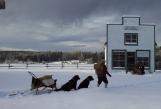
4
Winter at Huble Homestead/Giscome Portage 1915The late fall and winter were a time for checking traplines, using the snow to skid logs for building and to collect cordwood and of course to haul freight, especially furs from and to various markets.
It is 1915 in the dead of winter and another trip has to be made up to Fort McLeod. Ed Seebach (Al Huble's business partner) is seen here heading over to the Seebach and Huble Trading Post to get ready to go over the Giscome Portage with a load of Hudson Bay Company goods and furs. The sky looks menacing, as it gets ready to dump another layer of snow to blanket the ground. Ed is in a bit of a hurry because he knows how bad the weather can get in this northern country. He'll use the dogs today to sled over the snow already laid down on the portage. It's a long trip to where he will be heading today, all the way to Fort McLeod at the northern tip of McLeod Lake. The freight has to get into the Peace River area to the Hudson Bay Company there by the end of the week. There are many people expecting supplies there at the post.
Al Huble is standing in the front of the store with a pile of freight, which has to be loaded on the sled. The dogs will have to be tough this trip, with the winter weather threatening and the long journey ahead.
The Seebach and Huble store has been up and running since 1906, but this building is the new store built just two years ago in 1913. It's a fine store and trading post and it's stocked full of the many supplies the traveler or local homesteader would need. Al and Ed stocked everything from food and clothing to boats, traps, snowshoes and gunpowder. The location of the trading post was convenient too, with it being between the Peace River area and Fort George. The store supplied everyone in the local area as well as anyone going in to or out of the Peace River area.
So Ed is bundled up and almost ready to go, as he heads over to the trading post to load the final supplies to be freighted over the Giscome Portage and into Fort McLeod. It's a fine day so far, but the sky looks menacing!
6
"Stayed home at Giscome. Haynes, Wheeler, Baker, Sands and wife here for dinner" from Al Huble's Diary, Christmas Day, Friday, Dec. 25, 1914.There was a full house over for dinner this day.
The Huble children have told many stories about their father Al as well. Al Huble Jr. liked to talk about Christmas time with his dad. He said his dad would walk the forty-one miles through the northern forests into Fort George to buy Christmas goodies for the family. Al Jr. felt his father was a real family man.
In this picture we can imagine Al hauling home a Christmas tree on a sleigh pulled by a moose!
"He [Al Huble] found a baby moose and brought it home and they raised it with a bottle. When it got older, they made a harness for him and he pulled the children on a sleigh, just like a horse. It also used to open the screen door with its hoof and go into the house. They would have to open the door, on the other side of the house and let it wind its way through the house and out the other side." as told by Martha Huble
8
Giscome Portage Area CommunityThe Giscome Portage area was the home to over 20 homesteaders by 1915. In addition to this there were many people, including people of the First Nations who Huble Homestead often. On Christmas Day, 1914 the Hubles had Shorty Haynes (he is in the picture on the left), Earnest Wheeler, James Baker, John Sands and his wife over for dinner. Quite a crowd when you add the Hubles, their 4 children and probably Ed Seebach, too.
On October 8, 1910, the Fort George Herald ran an article. The article gave the names of twelve, of the original 18 pre-emptors, or settlers, who formed the core of the community around the Giscome Portage. The names were:
Wm. Tomkins, Wm. Griffiths, J.J. McGaghran, W. Thorn, James Baker, A. Bert, James Baker, J. Thompson, Joseph Burke, Joseph Hickie, William Bain and Robert Hines. Al Huble mentions most of these men in his diaries between 1909 and 1919. Two others not mentioned in this article are Jack Evans and Ivor Guest. A short piece on each of these two follows.
Jack Evans
Jack Boudreau, who wrote the book, "Crazy Man's Creek", explains that Jack Evans was known as a kindly man who told adventure stories of the forests and brought chocolate to children. Jack was born in England in 1867 and settled in Ontario for a time. He eventually arrived in the Fort George area where he spent the next several years trapping in the area north of the Salmon River. In 1908 Jack went up the Fraser River to Dewey where he took over a trap line that had been abandoned. The Quesnel Cariboo Observer of May 22, 1909, called it "the longest and best equipped trapline in British Columbia, this being a trapline over 100 miles long." According to Boudreau, "Jack was a quiet sincere gentleman who even at the age of 80, stood straight as a soldier." Jack passed through the Huble Homestead/Giscome Portage on many occasions. Albert Huble mentions this in his diaries from as early as 1910.
Ivor Guest
According to Russell Walker in "Bacon, Beans and Bravehearts", Ivor Guest was "one of the early pioneers, was an adventurous soul, never happy unless seeking new experiences." He recalled paying a social visit in 1916 at his little trading post a mile down the Pack River from the Hudson Bay Post at Fort McLeod. Ivor was apparently in the district of Fort George about 1911, and staked his land in 1912 while working for the B.C. Forest Service. He then went overseas and came back after the war to Fort McLeod, where he has been ever since. Ivor received a Crown Grant to his land after serving overseas in World War I. Walker described Ivor as "one of the real Prince George pioneers."
9
Lucille Adams (3rd from left), lived nearby in a home called Wild Geese Lodge1915
Summit Lake, British Columbia, Canada
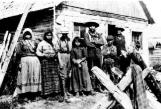
10
Lucille AdamsLucille lived in the Summit Lake area for a period of time in a home they called the 'Wild Geese Lodge', which she shared with her husband Jack. Lucille is pictured here third person in from the left.
In an interview of November of 2002, Al Jr. commented that Lucille was "a friend of Annie's". Huble described Lucille as "a flamboyant character", who had a habit of waving her teacup around in the air to strengthen the tea (while she talked). He also recalled Jack Adams, Lucille's husband, was a prospector who struck it rich following which, the two then married and built a home at Finlay Forks. Later in years, the two ended up at Summit Lake. In Peace River Chronicles, there were letters written by Lucille, wherein she describes her life in the Peace River (Finlay Forks) area. Lucille writes poignantly of the loss of an infant daughter and colorful descriptions of her life in the north. Apparently the Summit Lake home of Jack Adams and his charming wife, Lucille was famous far and near. Lucille's also dabbled in hydroponic gardening. Lucille applied garden seeds to sand, water, heat and chemicals to produce fresh leafy vegetables in the early spring and fall. Fresh vegetables in the spring and fall up in northern British Columbia, were unheard of.
12
Stoney Creek Charlie is seen here in ca. 1908 . Al Huble hired many First Nation men to help with the chores around the Giscome Portage.Pete Pierroy
Pete Pierroy worked for Al Huble in September of 1919 when he and Emmet (Shorty) Haynes hauled in oats off the fields. Al Huble's son, Sam, remembers Pete Pierroy as a native man, who attended Annie and the kids when they had the flu right at the end of the First World War. Sam stated, "He saved their lives". Apparently, Annie was alone with the kids at the Huble homestead and could not even get firewood (in the middle of the winter) or milk the cows. It has been documented that the flu epidemic of 1918 was malignant and spread like wild fire taking victims everywhere, especially the Nechako Valley. The people in some communities were left unable to make enough coffins and graves, as they were all more or less attacked by this flu. In one village, fourteen dead were buried in trenches in one day.
13
Pat Huble apparently often said that Father Nicholas Coccola, above, was like a family member1917
Huble Homestead/Giscome Portage on the Fraser River, North of Prince George, British Columbia, Canada
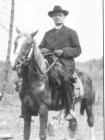
14
Father Nicholas CoccolaPat Huble was said to have reminisced about Father Nicholas Coccola, pictured here . She remembered that he was like part of the Huble family for a number of years. She also mentioned that he periodically lived in a cabin at the Giscome Portage homestead. When there, he worked with the First Nations above the homestead on the upper Fraser River. Father Coccola had some medical knowledge and became a friend of the white and Native people alike. He ate meals with the Huble family on numerous occasions. In addition to his medical knowledge, Father Coccola was of course also known for both his spiritual and educational work. He arrived in the New Caledonia area at Fort St. James in 1905 where he succeeded Father Morice.
Father Coccola was greatly beloved by the native people. He visited the native people quite regularly until 1914, when the village was moved to Shelley. Following which, his bi-annual visits were made outstanding events with a volley of musket and rifle fire and every native person in the village lining the riverbank to welcome him. In his book, "A Cross in the Wilderness", Cronin writes, that many people had thought that Father Coccola must have had formal training because he was so efficient at being a dentist, surgeon, midwife and doctor. It is said, "for tooth pulling, he used the only anesthetic available. He would knock the patient senseless with a good blow to the jaw, pull the tooth, then douse him with cold water to bring him around again".

